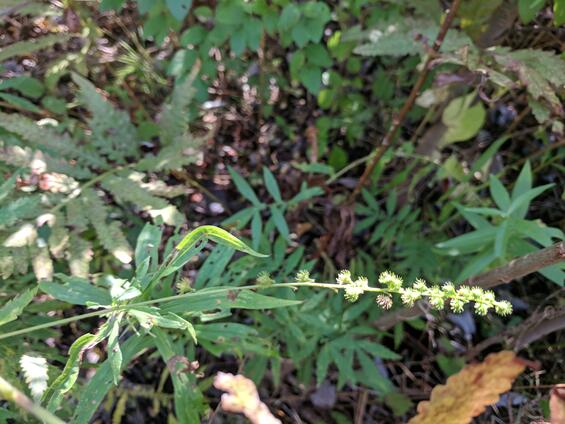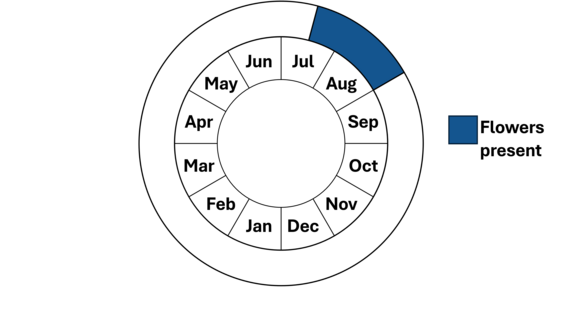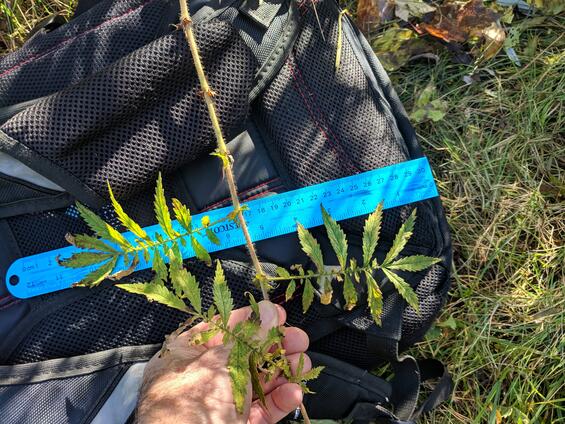- Scientific name: Agrimonia parviflora Ait.
- Species of Greatest Conservation Need (MA State Wildlife Action Plan)
- Endangered (MA Endangered Species Act)
Description

Small-flowered agrimony (Agrimonia parviflora). Photo credit: Robert Wernerehl
Small-flowered agrimony is a tall, herbaceous wildflower of the rose family (Rosaceae) that inhabits wet meadows, moist thickets, and edges in nutrient-rich soils associated with small rivers and streams. Its five-lobed yellow flowers, which are small relative to other agrimonies, are borne on a terminal raceme (an unbranched flowering stalk with individual floral stalks, or pedicels); the distinctive leaves are alternate, pinnately compound, and sharply toothed. The fruits have hooked bristles, enabling them to adhere to passing animals contributing to seed dispersal (ectozoochory).
Small-flowered agrimony can grow quite tall, 0.5-2 m (~1.5-6 ft.). The pinnately compound leaves are made up of 9 to 23 larger, lanceolate serrate leaflets, with three or four pairs of smaller leaflets interspersed. The leaflets, upper stem, flowering stalk, and hypanthium glisten with sessile glandular hairs. There are also long soft and short stiff non-glandular (eglandular) hairs. The yellow flowers, up to 120 in number, are small, and sub-oppositely arranged from the middle to upper raceme. Each flower has five yellow petals 1.5-2.9 mm (0.06-0.11 in) long that alternate with the five sepals. The achenes (one-seed fruit) form within the hypanthium (a structure that surrounds the ovary, then the fruit), which is widely bell-shaped (campanulate) with hooked bristles in rows around the upper rim. The persistent sepals at the top converge but are not fused. Fruits including the hypanthium are 1.3-3 mm (0.05-0.19 in) wide and 1.7- 3.8 mm (0.07-0.15 in) long and are reflexed at maturity. This species flowers in late summer and fruits in late summer to early autumn.
The morphological characters key to differentiating among agrimony species in Massachusetts are plant height, leaflet shape and number, type of pubescence, and presence/absence of glandular dots or hairs, especially on the flower stalk, leaves, and hypanthium.
Three other native agrimonies occur in Massachusetts; these are common agrimony (A. gryposepala), coarse agrimony (A. striata), and hairy agrimony (A. pubescens; threatened). All of these species are generally shorter, with smaller leaves, and wider (e.g., lance-ovate, obovate, or elliptic) major leaflets, that are typically fewer in number. They also have fewer pairs of the smaller interspersed leaflets than small-flowered agrimony. Common agrimony and coarse agrimony differ further in having a notably larger mature hypanthium, and the hypanthium of coarse agrimony is deeply grooved. Downy agrimony notably lacks glandular hairs and dots throughout and also has a deeply grooved hypanthium.

Population status
Small-flowered agrimony is listed under the Massachusetts Endangered Species Act as Endangered. All listed species are protected from killing, collecting, possessing, or sale and from activities that would destroy habitat and thus directly or indirectly cause mortality or disrupt critical behaviors. The MassWildlife’s Natural Heritage & Endangered Species Program (NHESP) database has 2 records from Berkshire County. Both records are from the town of Sheffield, and 1 has been observed within the last 25 years.

Photo credit: Robert Wernerehl
Distribution and abundance
Small-flowered agrimony is known from Ontario and much of the eastern and central United States, from Massachusetts and Connecticut west to Michigan, Iowa, and South Dakota, south to the Gulf states.

Distribution in Massachusetts
1999-2024
Based on records in the Natural Heritage Database
Habitat
In Massachusetts, small-flowered agrimony inhabits open, flat moist meadows and shallow marshy sites associated with streams and small rivers; the soils are rich, alluvial, calcareous soils. Known population locations have been used in the past for grazing and have been mown periodically. Species associated with small-flowered agrimony include Andrew’s bottle gentian (Gentiana andrewsii; Endangered), bottle gentian (Gentiana clausa), wetland sedges (several common and rare caliphilic Carex spp.), sweet flag (Acorus calamus), boneset (Eupatorium perfoliatum), wild bergamot (Monarda fistulosa), sensitive fern (Onoclea sensibilis), marsh fern (Thelypteris palustris), asters and goldenrods. Exotic pasture species including hay grasses and old-field growth shrubs, such as alders (Alnus incana ssp. rugosa), dogwoods, (Cornus spp.), willow (Salix spp.), and woody exotic invasive species may be present.
Healthy habitats are vital for supporting native wildlife and plants. Explore habitats and learn about conservation and restoration in Massachusetts.
Threats
A primary threat to small-flowered agrimony is succession of its open, somewhat disturbed habitat. More specifically, the rare agrimony is threatened by competition and over-shading from aggressive native (e.g., goldenrods, several shrub species) and exotic invasive plants when there is a lack of natural or anthropogenic disturbance. Exotic invasive plants noted within small-flowered agrimony habitat include reed canary grass (Phalaris arundinacea), Morrow’s honeysuckle (Lonicera morrowii), common buckthorn (Rhamnus cathartica), multiflora rose (Rosa multiflora), oriental bittersweet (Celastrus orbiculatus), Japanese barberry (Berberis thunbergii), and purple loosestrife (Lythrum salicaria). In addition, inappropriate application of management, for example mowing during the flowering or fruiting season, could reduce plant vigor and recruitment, especially over several years.
Conservation
Management
Invasive plants and encroaching native plants should be managed in small-flowered agrimony habitat to prevent over-shading.
Research needs
Small-flowered agrimony habitat locations should be monitored for over-shading and competition by aggressive native and exotic invasive species. If aggressive native or exotic plants are affecting this species, a plan should be developed, in consultation with NHESP, to alleviate the threat, through dormant season mowing or targeted plant removal. Long term management may be required to ensure the habitat quality is maintained in perpetuity. All active management of rare plant populations (including invasive species removal) is subject to review under the Massachusetts Endangered Species Act, and should be planned in close consultation with NHESP.
Animal seed dispersal of small-flowered agrimony enables the possibility of establishment of dynamic populations; thus it is possible that undocumented populations may be present in Massachusetts. Searches in appropriate habitat should be conducted.
Contact
| Date published: | April 7, 2025 |
|---|